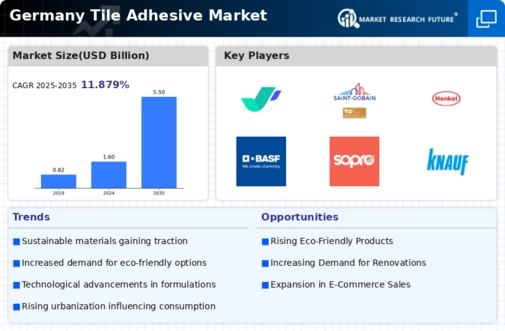The tile adhesive market in Germany exhibits a dynamic competitive landscape characterized by a blend of established players and emerging innovators. Key growth drivers include the increasing demand for sustainable construction materials, advancements in adhesive technology, and a robust construction sector. Major companies such as Henkel AG (DE), BASF SE (DE), and Sika AG (CH) are strategically positioned to leverage these trends. Henkel AG (DE) focuses on innovation and sustainability, emphasizing eco-friendly products, while BASF SE (DE) invests heavily in research and development to enhance product performance. Sika AG (CH) adopts a strategy of regional expansion, targeting growth in emerging markets, which collectively shapes a competitive environment that is both collaborative and competitive.
In terms of business tactics, companies are increasingly localizing manufacturing to reduce lead times and optimize supply chains. The market structure appears moderately fragmented, with several key players holding substantial market shares. This fragmentation allows for a diverse range of products and innovations, fostering competition that drives quality improvements and cost efficiencies across the sector.
In November 2025, Henkel AG (DE) announced the launch of a new line of eco-friendly tile adhesives designed to meet stringent environmental standards. This strategic move not only aligns with global sustainability trends but also positions Henkel as a leader in the green building materials segment. The introduction of these products is likely to enhance customer loyalty and attract environmentally conscious consumers, thereby strengthening Henkel's market position.
In October 2025, BASF SE (DE) unveiled a partnership with a leading technology firm to integrate AI into its production processes. This collaboration aims to optimize manufacturing efficiency and reduce waste, reflecting a broader trend towards digital transformation in the industry. By leveraging AI, BASF is expected to enhance its operational capabilities, potentially leading to cost reductions and improved product quality.
In September 2025, Sika AG (CH) expanded its operations in Eastern Europe by acquiring a local adhesive manufacturer. This acquisition is indicative of Sika's strategy to penetrate new markets and diversify its product offerings. The move not only enhances Sika's market presence but also allows for the integration of local expertise, which could lead to tailored solutions for regional customers.
As of December 2025, current competitive trends in the tile adhesive market are heavily influenced by digitalization, sustainability, and the integration of advanced technologies such as AI. Strategic alliances are increasingly shaping the landscape, enabling companies to pool resources and expertise. Looking ahead, competitive differentiation is likely to evolve from traditional price-based competition towards a focus on innovation, technology, and supply chain reliability. This shift underscores the importance of adaptability and forward-thinking strategies in maintaining a competitive edge.





















Leave a Comment